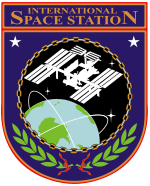Expedition 1
.png) Mission insignia |
|||||
| Call sign | Expedition 1 | ||||
|---|---|---|---|---|---|
| Number of crew | 3 | ||||
| Launch | 31 October 2000 07:52:47 UTC[1][2] | ||||
| Launch site | Baikonur Cosmodrome | ||||
| Launch craft | Soyuz TM-31 | ||||
| Start | 2 November 2000 09:21:03 UTC (docking)[3] | ||||
| End | 18 March 2001 04:32:00 UTC (undocking)[NASA 1] | ||||
| Landing | 21 March 2001 07:33:06 UTC (wheels stop)[NASA 2] | ||||
| Landing craft | Discovery STS-102 | ||||
| Landing site | Kennedy Space Center | ||||
| Duration | 136 days 17 hours 09 minutes (docking to hatch closing)[NASA 3] | ||||
| Mission duration | 140 days 23 hours 38 minutes (launch to landing)[2][NASA 3] | ||||
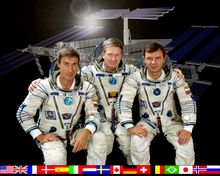 L-R: Sergei K. Krikalev (Russia), William M. (Bill) Shepherd (U.S.A.), and Yuri Pavlovich Gidzenko (Russia) |
|||||
|
|||||
Expedition 1, or Expedition One, was the first long-duration stay on the International Space Station (ISS). It began when the crew docked to the station on 2 November 2000 at 4:21 a.m. EST, aboard the non-re-usable Russian spacecraft Soyuz TM-31, which launched two days earlier.[3] The expedition ended when Space Shuttle Discovery undocked from the ISS, on 17 March 2001 at 10:32pm CST, with the three Expedition 1 crew members onboard.[NASA 4] It was immediately followed by Expedition 2, which was also launched with Discovery on STS-102.
During the crew's 136 days on board the station, they hosted three visiting Shuttle crews, which brought equipment, supplies, and key components of the space station. The first of these, STS-97, docked in early December 2000, and brought the first pair of large U.S. photovoltaic arrays, which increased the station's power capabilities five-fold.[NASA 5] The second visiting shuttle mission was STS-98, which was docked in mid-February 2001, delivered the US$ 1.4 billion research module Destiny, which increased the mass of the station beyond that of Mir for the first time.[NASA 6] Mid-March 2001 saw the final shuttle visit of the expedition, STS-102, whose main purpose was to exchange the Expedition 1 crew with the next three person long-duration crew, Expedition 2.[NASA 7]
The Expedition 1 crew consisted of an American commander and two Russians.[NASA 3] The commander, Bill Shepherd, was a former Navy SEAL, whose only spaceflights were on shuttle missions before which lasted at most a week.[NASA 8] Yuri Gidzenko, who was designated commander and pilot of the two-day Soyuz mission to the station, had one previous spaceflight, which was a 180 day stay aboard Mir.[NASA 9] Sergei K. Krikalev was the one crew member who had previously visited the ISS, which he did in 1998 as one of the first people to enter the station. At the start of Expedition 1, Krikalev had four previous spaceflights and had logged over a full year in space, mostly aboard Mir, making him by far the most experienced.[NASA 10][4]
During their mission, the Expedition 1 crew activated various systems on board the station, unpacked equipment that had been delivered, as well as unloaded two unmanned Russian Progress resupply vehicles, which were launched during the crew's stay. The crew worked was very busy throughout the mission,[5] which was originally planned to be completed in February, but was extended due to shuttle delays. The expedition marked the beginning of a continuous human presence on the ISS, which still lasts, as of August 2010.
Contents |
Crew
| Position | Astronaut | |
|---|---|---|
| Commander | William Shepherd, NASA Fourth spaceflight |
|
| Pilot | Sergei K. Krikalev, RSA Fifth spaceflight |
|
| Flight Engineer | Yuri Gidzenko, RSA Second spaceflight |
|
Crew notes
The commander, Bill Shepherd, was a former Navy SEAL, whose only spaceflights were on shuttle missions, and at the beginning of the mission his total time is space was about two weeks.[NASA 8] Questions had been raised by the Russian space agency about the choice of Shepherd as mission commander due to his lack of experience.[4] Flight engineer Sergei Krikalev had spent over a year in orbit, mostly on Mir, and would become the first person to visit the ISS twice. He felt excitement to have been one of the first people to enter to Zarya module in 1998, during STS-88, and was looking forward to returning.[NASA 11] Yuri Gidzenko was designated commander and pilot of the two-day Soyuz mission to the station, had one previous spaceflight, which was a 180 day stay aboard Mir.[NASA 9]
Shepherd was only the second U.S. astronaut to be launched in a Russian spacecraft, the first being Norman Thagard, who launched on Soyuz TM-21 to visit Mir in 1995.[NASA 12] Shepherd expected one of the biggest challenges for the ISS would be the compatibility of technologies, such as that between Russian and U.S. technologies.[NASA 13]
Background
The first component of the space station was the Zarya module, which was launched unmanned in November 1998.[NASA 14] Following this launch, and prior to Expedition 1, there were five manned Space Shuttle flights and two unmanned Russian flights to the ISS.[6] Some of these flights delivered large modules, such as the pressurized Unity and Zvezda modules, and the first piece of the Integrated Truss Structure. The manned flights were used for partial assembly of the ISS, as well as to start unpacking the supplies and equipment that we being delivered.[4] Prior to Expedition 1, Krikalev expected the ISS to be very similar to his experience on Mir ten years previous, due to the physical similarities of the stations' components.[NASA 11]
The launch of the Expedition 1 crew occurred a week before the United States presidential election, so it got little attention in the United States.[7] At the time of the mission, the station was expected to be completed in 2006, and be continuously inhabited until at least 2015.[8] Due to several delays, including the fallout from the Space Shuttle Columbia disaster, the station is expected to be completed in late 2011.
Mission highlights
The crew of three were on board the International Space Station for four and a half months, from early November 2000 to mid-March 2001. Major events during this time include the three week long Space Shuttle visits, which occurred in early December, mid-February, and at the end of the expedition in March.
Launch and docking
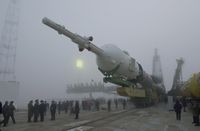
The three-member Expedition One crew successfully launched 31 October 2000 atop a Soyuz-U rocket on Soyuz TM-31 from the Baikonur Cosmodrome in Kazakhstan; they used launch pad Gagarin's Start, from which the first human to fly in space, Yuri Gagarin, was launched in 1961.[9][10][NASA 12] After 33 orbits of the Earth, and a series of rendezvous maneuvers performed by Gidzenko, they docked the Soyuz capsule to the aft port of the Zvezda Service Module on 2 November 2000.[4] Ninety minutes after docking, Shepherd opened the hatch to Zvezda and the crew members entered the complex.
Alpha
At the end of the first day on the station, Shepherd requested the use of the radio call sign "Alpha", which he and Krikalev preferred it to the more cumbersome "International Space Station".[4] The name "Alpha" had previously been used for the station in the early 90's,[11] and following the request, its use was authorized for the whole of Expedition One.[12] Shepherd had been advocating the use of a new name to project managers for some time. Referencing a naval tradition in a pre-launch news conference he had said: "For thousands of years, humans have been going to sea in ships. People have designed and built these vessels, launched them with a good feeling that a name will bring good fortune to the crew and success to their voyage."[3] Yuri Semenov, the President of Russian Space Corporation Energia at the time, disapproved of the name "Alpha"; he felt that Mir was the first space station, and so he would have preferred the names "Beta" or "Mir 2" for the ISS.[12][13]
First month

In their first weeks on board, the Expedition 1 crew members activated critical life support systems and computer control, as well as unpacked supplies left behind for them by previous supply missions. At this time the station did not have enough electricity to heat all three pressurized modules, so Unity was left unused and unheated.[14] Unity had been used for the past two years to allow U.S. flight controllers to command ISS systems and read station system data.
The Russian unmanned resupply spacecraft Progress M1-4 docked to the station on 18 November. The Progress spacecraft's automatic docking system failed, necessitating a manual docking controlled by Gidzenko using the TORU docking system.[15] Although manual dockings are routine, they have caused some concern among flight controllers since an attempt in 1997 which resulted in the spacecraft colliding with Mir, causing significant damage.[16]
The astronauts had a heavy workload in the first month, as Shepherd told reporters in a space-to-ground interview: "To me, the biggest challenge is trying to pack 30 hours into an 18-hour work day."[17] Some of the early tasks took longer than scheduled. For example, the activation of a food warmer in Zvezda's galley was scheduled for 30 minutes, but it took the astronauts a day and a half to turn it on.[18]
STS-97
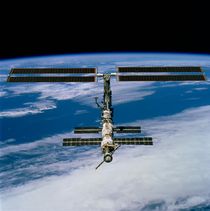
Space Shuttle Endeavour docked with the ISS on 2 December 2000, on mission STS-97, bringing four more Americans and a Canadian temporarily to the station. The shuttle also brought the first pair of U.S. provided photovoltaic arrays, which would provide crucial electricity for further development of the station. In total, STS-97 brought 17-tons of equipment to the ISS, which also included expandable metal girders, batteries, electronics and cooling equipment.[8]
Three spacewalks were conducted by the crew of STS-97, all of which were completed prior to opening the hatch between shuttle and station. On 8 December, the hatch between the two was opened and the two crews greeted each other for the first time. It had remained closed to maintain their respective atmospheric pressures.[19] The Expedition 1 crew took this opportunity to leave the station and tour the inside of the space shuttle, which was thought to be good for their psychological well-being.[14]
Progress M1-4
Prior to Endeavour docking, the Russian resupply spacecraft Progress M1-4, which came to the station in mid-November, was undocked to make room for the space shuttle.[20] This Progress spacecraft remained undocked for the duration of STS-97, parked in orbit about a mile away from the station. It docked manually again with the station on December 26 by Gidzenko, after Endeavour left. The automatic docking system for this Progress spacecraft had failed on the first docking in November.[21] The crew spent much of the following week unloading the Progress spacecraft.[NASA 15]
Christmas and New Years
On Christmas day, the Expedition 1 crew were given the day off work. They opened presents delivered by Endeavour and the Progress supply ship.[22] They also each took turns speaking to their families. In the following days they did several video downlinks, some with Russian TV stations.[21] The crew had a quiet New Years. Citing a Naval tradition, for the New Year's entry of the station's log, Shepherd provided a poem on behalf of the crew.[NASA 16]
STS-98
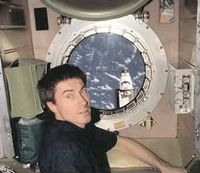
On 9 February 2001, Space Shuttle Atlantis docked to the ISS, bringing the five American crew members of STS-98 temporarily to the station. The mission was originally planned for mid-January, but was delayed due to NASA's concerns about some cables on the shuttles.[23] This mission brought the 16-ton U.S. built Destiny laboratory, which was installed with the use of the shuttle's robotic Canadarm, controlled by Marsha Ivins. Astronauts Thomas D. Jones and Robert L. Curbeam helped with the installation during a spacewalk. The Destiny module had a cost of $1.4 billion US$, and would be used primarily for scientific research.[24][25] During the spacewalk an ammonia coolant leak created a contamination scare, which happened when Curbean was hooking up coolant lines to Destiny.[26] The other two spacewalks went ahead without any problems. While the Shuttle was docked, the control of the station's orientation was switched from propellants to electrically powered gyroscopes, which had been installed in September 2000. The gyroscopes had not been used earlier due to the lack of key navigational electronics.[NASA 17]
By the end of STS-98, the crew of Expedition 1 had been on the station for over three months, and Shepherd stated that he was "ready to come home".[27] NASA used several techniques to prevent the three crew members from suffering the effects of the "three-month wall" psychological barrier, which had caused depression in previous astronauts. For example they allowed more time for the crew to speak to their families via videophone, and they also encouraged them to watch movies and listen to music they like.[14]
Progress M-44
On 28 February the third Progress spacecraft to visit the ISS, Progress M-44, docked to the Zvezda module. It brought air, food, rocket fuel and other equipment.[28] It remained docked until Expedition 2, when it was intentionally burnt up during atmospheric reentry, like all Progress spacecraft.
STS-102
Space Shuttle Discovery docked on 10 March 2001, bringing to the ISS the new long-duration three person crew of Expedition 2, as well as four short-term crew member of STS-102. A few hours after docking, the hatch opened, and all ten astronauts greeted each other, setting a new record for the number people simultaneously in the ISS.[29] The day after docking, American astronauts Jim Voss and Susan Helms began a spacewalk which ended up being nearly 9 hours long, and still holds the record for the longest spacewalk ever performed, as of August 2010. The length of the spacewalk was partially do to some mistakes, including Voss accidentally releasing a small tool. Unable to retrieve it, NASA engineers tracked the tool, and decided to use Discovery's thrusters on 14 March to boost the station four kilometers higher, to ensure the ISS would not collide with the piece of space debris.[30]
Transferring expedition crews
By 14 March, the expedition crews had completed the change over, but until the shuttle undocked, Shepherd officially remained commander of the station.[31] The morning of the 14th the astronauts' wake-up call was the song "Should I Stay or Should I Go" by The Clash, at the request of Shepherd's wife.[30] Shepherd, a former Navy SEAL, said during the change over ceremony: "May the good will, spirit and sense of mission we had enjoyed on board endure. Sail her well."[32] The commander of Space Shuttle Discovery, Jim Wetherbee, said ""For Captain Shepherd and his crew, we hold you in admiration as we prepare to bring you home. This has been an arduous duty for you. This ship was not built in a safe harbor. It was built on the high seas."[32]
Undocking and landing
The crew's four and a half month tour aboard the ISS officially ended on 18 March 2001, when Discovery undocked. The Expedition 1 crew returned home to Earth on STS-102, landing on 21 March 2001, on a rare night landing at 2:30am local time.[33] Two days after the landing, coincidentally, Mir was intentionally burned up during atmospheric reentry, ending its 15 years in orbit.
Daily activities
On a typical morning on the station, the crew's day began with an electronic wake-up tone at about midnight EST.[NASA 12] Then the crew was given about two hours to clean up, have breakfast, and read morning mail which had been uplinked to them from U.S. flight controllers.[NASA 12] Their work day included a lunch break at midday, and ended with a mid-afternoon planning session with flight controllers, regarding the next day's activities.[NASA 12][18]
Ground communications
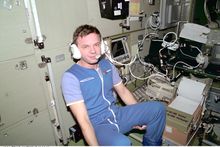
Until the Unity module was available for use a month into the mission, the astronauts used the Russian communications gear in Zvezda and the Zarya module to communicate with the Russian Mission Control Center in Korolev, outside Moscow.[4] With the arrival of the solar arrays on STS-97, they activated the S-band Early Communication gear in the Unity Module, allowing for communication with Mission Control in Houston. They also installed the initial Amateur Radio on the International Space Station and performed contacts with a number of schools.
Science activities
Unlike future expeditions, the crew of Expedition 1 had a somewhat modest amount of science experiments to conduct.[NASA 12] Some science activities included a low-maintenance protein crystal growth experiment;[NASA 18] Crew Earth Observations, where the crew took photographs to record dynamic events on the Earth's surface such as storms or fires;[NASA 19] measuring their heart rates and the station's carbon dioxide levels to determine the effect of exercise on the station.[NASA 12]
IMAX filming
Throughout the mission the Expedition 1 crew filmed footage for use in the IMAX documentary film, Space Station 3D.[34] Highlights of the footage include the first entry into the Destiny module, during STS-98; the Expedition 1 crew showering and shaving in zero gravity; and the docking of STS-102, followed by the change over to the Expedition 2 crew.[34]
References
- ↑ "Energia Press Release on the Soyuz TM-31 (Expedition 1) Launch". SpaceRef.com. 31 October 2000. http://www.spaceref.com/news/viewsr.html?pid=1391. Retrieved 11 August 2010.
- ↑ 2.0 2.1 "EXPEDITION ONE (ISS-1) - CREWS OF THE FIRST LONG-DURATION EXPRDITION". Energia. http://www.energia.ru/eng/iss/iss01/iss-crew01.html. Retrieved 11 August 2010.
- ↑ 3.0 3.1 3.2 Todd Halvorson. "Space Station Is Opened For Business As Expedition One Crew Floats Aboard". Space.com. http://www.space.com/missionlaunches/missions/exp1_am_001102.html. Retrieved 7 August 2010.
- ↑ 4.0 4.1 4.2 4.3 4.4 4.5 Brad Liston (2 November 2000). "Upward Bound: Tales of Space Station Alpha". TIME. http://www.time.com/time/arts/article/0,8599,59500,00.html. Retrieved 5 August 2010.
- ↑ Todd Halvorson (24 January 2001). "ISS Crew Works Feverishly; Shepherd OK with Tourist Tito". Space.com. http://www.space.com/missionlaunches/missions/chaikin_transcript_010124.html. Retrieved 8 August 2010.
- ↑ "SPACE FLIGHT 2001 -- International Space Station". NASA. http://www.nasa.gov/directorates/somd/reports/2001/iss_prt.htm. Retrieved 5 August 2010.
- ↑ "Opening the Space Station". The New York Times. 1 November 2000. http://www.nytimes.com/2000/11/01/opinion/opening-the-space-station.html. Retrieved 5 August 2010.
- ↑ 8.0 8.1 Warren E. Leary (30 November 2000). "Shuttle to Lift Off Tonight for Space Station". The New York Times. http://www.nytimes.com/2000/11/30/us/shuttle-to-lift-off-tonight-for-space-station.html. Retrieved 4 August 2010.
- ↑ "Space station launch follows Russian tradition". CTV Edmonton. 30 October 2000. http://www.ctvbc.ctv.ca/servlet/an/plocal/CTVNews/20001030/ctvnews77753/20001030/?hub=EdmontonHome. Retrieved 5 August 2010.
- ↑ "Let the new space era begin". ABC. 6 November 2000. http://www.abc.net.au/science/articles/2000/11/06/207767.htm?site=science_dev&topic=latest. Retrieved 5 August 2010.
- ↑ "Space Station - Impact on the expanded Russian role of funding and research". United State General Accounting Office. 21 June 1994. http://archive.gao.gov/t2pbat3/151975.pdf. Retrieved 9 August 2010.
- ↑ 12.0 12.1 Alan Ladwig (3 November 2000). "Call Bill Shepherd the Alpha Male of the International Space Station". Space.com. http://www.space.com/missionlaunches/missions/alpha_male_001103.html. Retrieved 9 August 2010.
- ↑ "Interview with RSC Energia's Yuri Semenov". Space.com. 3 September 2001. http://www.spaceref.com/news/viewpr.html?pid=5913. Retrieved 22 August 2010.
- ↑ 14.0 14.1 14.2 Steven Siceloff (7 January 2001). "Space Station Crew Ready for 'Three-Month-Wall'". Space.com. http://www.space.com/missionlaunches/missions/fl_iss_010107.html. Retrieved 6 August 2010.
- ↑ Todd Halvorson (18 November 2000). "Progress Cargo Ship Docks with ISS". Space.com. http://www.space.com/missionlaunches/missions/exp1_progressdocking_001118.html. Retrieved 9 August 2010.
- ↑ William Harwood (21 December 2000). "Redocking of station cargo ship will be tricky affair". Spaceflightnow.com. http://www.spaceflightnow.com/station/stage5a/001221update/. Retrieved 18 August 2010.
- ↑ Todd Halvorson (29 November 2000). "Expedition 1 Crew Prepares For House Guest". Space.com. http://www.space.com/missionlaunches/missions/ex1_update_001128.html. Retrieved 9 August 2010.
- ↑ 18.0 18.1 Todd Halvorson (3 November 2000). "Space Station Alpha Crew Settles Into Daily Routine". Space.com. http://www.space.com/missionlaunches/missions/exp1_am_001103.html. Retrieved 10 August 2010.
- ↑ "Mission archives - STS-97". NASA. http://www.nasa.gov/mission_pages/shuttle/shuttlemissions/archives/sts-97.html. Retrieved 4 August 2010.
- ↑ "Shuttle Nearing Space Station And Causing A Traffic Jam". The New York Times. 2 December 2000. http://www.nytimes.com/2000/12/02/us/shuttle-nearing-space-station-and-causing-a-traffic-jam.html. Retrieved 6 August 2010.
- ↑ 21.0 21.1 "Expedition One December Crew Log". NASA. http://spaceflight.nasa.gov/station/crew/exp1/exp1shepdec.html. Retrieved 6 August 2010.
- ↑ "Space station in UK skies". BBC. 25 December 2000. http://news.bbc.co.uk/2/hi/uk_news/1087086.stm. Retrieved 6 August 2010.
- ↑ "Destiny lab lifts off". BBC. 7 February 2001. http://news.bbc.co.uk/2/hi/science/nature/1154528.stm. Retrieved 6 August 2010.
- ↑ "Mission archives - STS-98". NASA. http://www.nasa.gov/mission_pages/shuttle/shuttlemissions/archives/sts-98.html. Retrieved 4 August 2010.
- ↑ "Astronauts complete delicate mission". BBC. 10 February 2001. http://news.bbc.co.uk/2/hi/science/nature/1163598.stm. Retrieved 4 August 2010.
- ↑ Todd Halvorson (10 February 2001). "Destiny Installed Despite Toxic Coolant Leak". Space.com. http://www.space.com/missionlaunches/missions/sts98_eva1pm_010210.html. Retrieved 6 August 2010.
- ↑ Todd Halvorson (20 February 2001). "Destiny Fulfilled: Atlantis Ends Mission With Safe Touchdown". Space.com. http://www.space.com/missionlaunches/missions/sts98_land_010220.html. Retrieved 6 August 2010.
- ↑ "Space station prepares for supplies". BBC. 26 February 2001. http://news.bbc.co.uk/2/hi/science/nature/1187901.stm. Retrieved 6 August 2010.
- ↑ "Mission archives - STS-102". NASA. http://www.nasa.gov/mission_pages/shuttle/shuttlemissions/archives/sts-102.html. Retrieved 4 August 2010.
- ↑ 30.0 30.1 "Space station dodges floating debris". BBC. 15 March 2001. http://news.bbc.co.uk/2/hi/science/nature/1221955.stm. Retrieved 6 August 2010.
- ↑ "Space station crews change over". BBC. 14 March 2001. http://news.bbc.co.uk/2/hi/science/nature/1218603.stm. Retrieved 6 August 2010.
- ↑ 32.0 32.1 Todd Halvorson (18 March 2001). "Changing of the Guard Takes Place at Space Station Alpha". Space.com. http://www.space.com/missionlaunches/missions/sts102_command_010318.html. Retrieved 6 August 2010.
- ↑ "Shuttle makes night landing". BBC. 21 March 2001. http://news.bbc.co.uk/2/hi/science/nature/1233162.stm. Retrieved 6 August 2010.
- ↑ 34.0 34.1 "FILM SUMMARY AND HIGHLIGHTS OF FIRST-EVER LOCKHEED MARTIN-SPONSORED IMAX®3D SPACE FILM". IMAX. http://www.imax.com/spacestation/html/ss_film_summary.html. Retrieved 6 August 2010.
NASA
- ↑ "STS-102 Day 12 Highlights". NASA. http://science.ksc.nasa.gov/shuttle/missions/sts-102/sts-102-day-12-highlights.html. Retrieved 11 August 2010.
- ↑ "NASA STS-102 Mission summary". NASA. http://science.ksc.nasa.gov/shuttle/missions/sts-102/mission-sts-102.html. Retrieved 11 August 2010.
- ↑ 3.0 3.1 3.2 "ISS Expedition One Crew". NASA. http://spaceflight.nasa.gov/station/crew/exp1/index.html. Retrieved 7 August 2010.
- ↑ "STS-102 Mission Control Center Status Report # 23". NASA. 19 March 2001. http://www.nasa.gov/centers/johnson/news/shuttle/sts-102/STS-102-23.html. Retrieved 7 August 2010.
- ↑ "STS-97 Delivers Giant Solar Arrays to International Space Station". NASA. http://spaceflight.nasa.gov/shuttle/archives/sts-97/. Retrieved 7 August 2010.
- ↑ "STS-98 Delivers Destiny Lab to International Space Station". NASA. http://spaceflight.nasa.gov/shuttle/archives/sts-98/. Retrieved 7 August 2010.
- ↑ "STS-102 Swaps International Space Station Crews". NASA. http://spaceflight.nasa.gov/shuttle/archives/sts-102/. Retrieved 7 August 2010.
- ↑ 8.0 8.1 "Astronaut Bio - W.M. Shepherd". NASA. June, 2001. http://www.jsc.nasa.gov/Bios/htmlbios/shepherd.html. Retrieved 7 August 2001.
- ↑ 9.0 9.1 "Cosmonaut Bio: Gidzenko". NASA. http://www.jsc.nasa.gov/Bios/htmlbios/gidzenko.html. Retrieved 7 August 2010.
- ↑ "Cosmonaut Bio: Sergei Krikalev". NASA. http://www.jsc.nasa.gov/Bios/htmlbios/krikalev.html. Retrieved 7 August 2010.
- ↑ 11.0 11.1 "Preflight interview: Sergei Kirkalev". NASA. http://spaceflight.nasa.gov/station/crew/exp1/intkrikalev.html. Retrieved 22 August 2010.
- ↑ 12.0 12.1 12.2 12.3 12.4 12.5 12.6 "Expedition One Crew brings the station to life - NASA press kit (PDF)". NASA. 25 October 2000. http://spaceflight.nasa.gov/station/crew/exp1/exp1_presskit.pdf. Retrieved 8 August 2010.
- ↑ "Preflight Interview: Bill Shepherd". NASA. http://spaceflight.nasa.gov/station/crew/exp1/intshepherd.html. Retrieved 22 August 2010.
- ↑ "Zarya module". NASA. http://www.nasa.gov/mission_pages/station/structure/elements/fgb.html. Retrieved 8 August 2010.
- ↑ "INTERNATIONAL SPACE STATION STATUS REPORT #63". NASA. 26 December 2000. http://spaceflight.nasa.gov/spacenews/reports/issreports/2000/iss00-63.html. Retrieved 24 August 2010.
- ↑ "INTERNATIONAL SPACE STATION STATUS REPORT #64". NASA. 31 December 2000. http://spaceflight.nasa.gov/spacenews/reports/issreports/2000/iss00-64.html. Retrieved 24 August 2010.
- ↑ "STS-98 Day 7 Highlights". NASA. http://science.ksc.nasa.gov/shuttle/missions/sts-98/sts-98-day-07-highlights.html. Retrieved 10 August 2010.
- ↑ "Protein Crystal Growth-Enhanced Gaseous Nitrogen Dewar (PCG-EGN)". NASA. 26 June 2010. http://www.nasa.gov/mission_pages/station/science/experiments/PCG-EGN.html. Retrieved 8 August 2010.
- ↑ "Crew Earth Observations". NASA. 16 July 2010. http://www.nasa.gov/mission_pages/station/science/experiments/CEO.html. Retrieved 8 August 2010.
External links
- "Expedition One Crew (with Mission overview)". NASA. http://spaceflight.nasa.gov/station/crew/exp1/index.html. Retrieved 4 August 2010.
|
|||||||||||||||||
